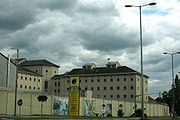
Graz-Karlau Prison
Encyclopedia


Graz
The more recent population figures do not give the whole picture as only people with principal residence status are counted and people with secondary residence status are not. Most of the people with secondary residence status in Graz are students...
in the Austria
Austria
Austria , officially the Republic of Austria , is a landlocked country of roughly 8.4 million people in Central Europe. It is bordered by the Czech Republic and Germany to the north, Slovakia and Hungary to the east, Slovenia and Italy to the south, and Switzerland and Liechtenstein to the...
n state of Styria. With a capacity of 552 inmates, Graz-Karlau is the third largest prison in Austria.
History
Built between 1584 and 1590 in late Renaissance styleRenaissance architecture
Renaissance architecture is the architecture of the period between the early 15th and early 17th centuries in different regions of Europe, demonstrating a conscious revival and development of certain elements of ancient Greek and Roman thought and material culture. Stylistically, Renaissance...
to designs by Antonio Tade and Antonio Marmoro, it was used as a summer hunting residence for Archduke Karl II of Austria
Charles II, Archduke of Austria
Charles II Francis of Austria was an Archduke of Austria and ruler of Inner Austria from 1564...
.
Originally, it was called "Dobel Castle". The German word "Dobel" is also written "Tobel", a deep, ravine-like valley or can also be a place and field-name. Because the castle's name was similar to the nearby "Tobel hunting-lodge" situated in Haselsdorf-Tobelbad
Haselsdorf-Tobelbad
Haselsdorf-Tobelbad is a municipality in the district of Graz-Umgebung in Styria, Austria....
, it was renamed as "Karlau", after the archduke.
From 1769 it was used as a workhouse
Workhouse
In England and Wales a workhouse, colloquially known as a spike, was a place where those unable to support themselves were offered accommodation and employment...
and in 1794 started to keep French prisoners of war
Prisoner of war
A prisoner of war or enemy prisoner of war is a person, whether civilian or combatant, who is held in custody by an enemy power during or immediately after an armed conflict...
. In 1803, it became a provincial prison for inmates who had sentences of up to 10 years of imprisonment. In 1847 to 1848 and from 1869 to 1872, it was greatly enlarged. Toward the end of World War II
World War II
World War II, or the Second World War , was a global conflict lasting from 1939 to 1945, involving most of the world's nations—including all of the great powers—eventually forming two opposing military alliances: the Allies and the Axis...
the prison was bombed twice, which killed 14 guards and 107 prisoners. In 1946, the British executioner Albert Pierrepoint
Albert Pierrepoint
Albert Pierrepoint is the most famous member of the family which provided three of the United Kingdom's official hangmen in the first half of the 20th century...
travelled to Karlau to train an Austrian executioner and two assistants in the British method of long drop executions. Until then, condemned prisoners were hanged with short drops, effectively strangling them to death. Under the British method, Pierrepoint, the Austrian executioner and the two assistants hanged eight young men on September 24, 1946.
A method which was continued until Austria abolished capital punishment
Capital punishment
Capital punishment, the death penalty, or execution is the sentence of death upon a person by the state as a punishment for an offence. Crimes that can result in a death penalty are known as capital crimes or capital offences. The term capital originates from the Latin capitalis, literally...
on June 30, 1950.
The prison was renamed Graz-Karlau on November 1, 1993.
Notable inmates
Among the prison's inmates, it houses or housed prisoners such as the serial killer Jack UnterwegerJack Unterweger
Johann "Jack" Unterweger was an Austrian serial killer who murdered prostitutes in several countries. First convicted of a 1974 murder, he was released in 1990 due in part to a campaign by intellectuals and politicians, who regarded Unterweger as an example of rehabilitation...
, the letter and pipe bomb terrorist Franz Fuchs
Franz Fuchs
Franz Fuchs was a xenophobic Austrian terrorist. Between 1993 and 1997 he killed four people and injured 15, some of them seriously, using three improvised explosive devices and five waves of 25 mailbombs in total.Fuchs' mailbomb campaigns and his personality features are according to criminal...
, the six-times murderer Udo Proksch
Udo Proksch
Udo Proksch was an Austrian businessman and industrialist. In 1991, he was convicted of the murder of six people as part of a major insurance fraud. Proksch died in prison....
, the suspected serial killer Wolfgang Ott, or the terrorist Tawfik Ben Chaovali who was involved in the Rome and Vienna airport attacks
Rome and Vienna airport attacks
The Rome and Vienna airport attacks were two major terrorist strikes carried out on December 27, 1985.- The attacks :At 08:15 GMT, four gunmen walked to the shared ticket counter for Israel's El Al Airlines and Trans World Airlines at Leonardo da Vinci-Fiumicino Airport outside Rome, Italy, fired...
.

